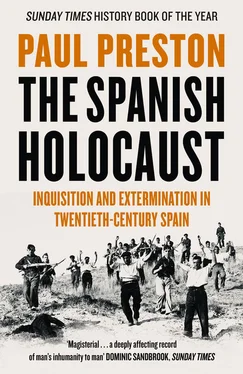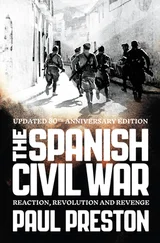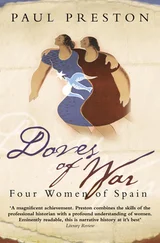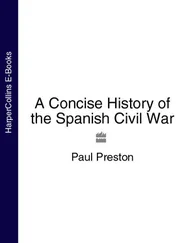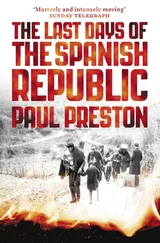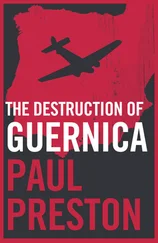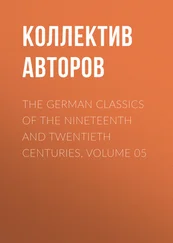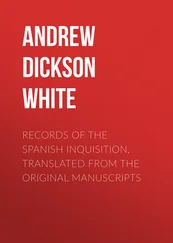No military threat from those making the long trek to the French border. (Photos 12/Alamy)
A crowd of Spanish women and children refugees cross the border into France at Le Perthus. (Hulton-Deutsch Collection/CORBIS)
Recently arrived at Argelès, women await classification. (Roger-Viollet/Rex Features)
The male refugees are detained at Argelès – the only facility being barbed wire. (Hulton-Deutsch Collection/CORBIS)
Prisoners carry rocks up the staircase at the Mauthausen-Gusen death camp. (akg-images/ullstein bild)
Franco welcomes Himmler to Madrid. (EFE/Hermes Pato/jgb)
Antonio Vallejo-Nájera. (EFE/jgb)
Himmler visits the psycho-technic checa of Alfonso Laurencic in Barcelona. (L’Arxiu Fotogràfic de Barcelona)
Drawings made by Simon Manfield during the excavation at Valdedios, Asturias, summer 2003. (© Simon Manfield. Part of the Memoria Histórica series, simonmanfield@hotmail.com)
Behind the lines during the Spanish Civil War, nearly 200,000 men and women were murdered extra-judicially or executed after flimsy legal process. They were killed as a result of the military coup of 17–18 July 1936 against the Second Republic. For the same reason, perhaps as many as 200,000 men died at the battle fronts. Unknown numbers of men, women and children were killed in bombing attacks and in the exoduses that followed the occupation of territory by Franco’s military forces. In all of Spain after the final victory of the rebels at the end of March 1939, approximately 20,000 Republicans were executed. Many more died of disease and malnutrition in overcrowded, unhygienic prisons and concentration camps. Others died in the slave-labour conditions of work battalions. More than half a million refugees were forced into exile and many were to die of disease in French concentration camps. Several thousand were worked to death in Nazi camps. The purpose of this book is to show as far as possible what happened to civilians and why. All of what did happen constitutes what I believe can legitimately be called the Spanish holocaust.
I thought long and hard about using the word ‘holocaust’ in the title of this book. I feel intense sorrow and outrage about the Nazis’ deliberate attempt to annihilate European Jewry. I also feel intense sorrow and outrage about the lesser, but none the less massive, suffering undergone by the Spanish people during the Civil War of 1936–9 and for several years thereafter. I could find no word that more accurately encapsulates the Spanish experience than ‘holocaust’. Moreover, in choosing it, I was influenced by the fact that those who justified the slaughter of innocent Spaniards used an anti-Semitic rhetoric and frequently claimed that they had to be exterminated because they were the instruments of a ‘Jewish–Bolshevik–Masonic’ conspiracy. Nevertheless, my use of the word ‘holocaust’ is not intended to equate what happened within Spain with what happened throughout the rest of continental Europe under German occupation but rather to suggest that it be examined in a broadly comparative context. It is hoped thereby to suggest parallels and resonances that will lead to a better understanding of what happened in Spain during the Civil War and after.
To this day, General Franco and his regime enjoy a relatively good press. This derives from a series of persistent myths about the benefits of his rule. Along with the carefully constructed idea that he masterminded Spain’s economic ‘miracle’ in the 1960s and heroically kept his country out of the Second World War, there are numerous falsifications about the origins of his regime. These derive from the initial lie that the Spanish Civil War was a necessary war fought to save the country from Communist take-over. The success of this fabrication influenced much writing on the Spanish Civil War to depict it as a conflict between two more or less equal sides. The issue of innocent civilian casualties is subsumed into that concept and thereby ‘normalized’. Moreover, anti-communism, a reluctance to believe that officers and gentlemen could be involved in the deliberate mass slaughter of civilians and distaste for anti-clerical violence go some way to explaining a major lacuna in the historiography of the war.
The extent to which the rebels’ war effort was built on a prior plan of systematic mass murder and their subsequent regime on state terror is given relatively little weight in the literature on the Spanish conflict and its aftermath. The same may be said of the fact that a chain reaction which fuelled retaliatory mass assassinations within the loyalist zone was set off once the exterminatory plans of the military rebels began to be implemented from the night of 17 July 1936. The collective violence in both rearguards unleashed by brutal perpetrators against undeserving victims justifies the use of the word ‘holocaust’ in this context not just because of its extent but also because its resonances of systematic murder should be invoked in the Spanish case, as they are in those of Germany and Russia.
There were two rearguard repressions, one each in the Republican and rebel zones. Although very different, both quantitatively and qualitatively, each claimed tens of thousands of lives, most of them innocent of wrongdoing or even of political activism. The leaders of the rebellion, Generals Mola, Franco and Queipo de Llano, regarded the Spanish proletariat in the same way as they did the Moroccan, as an inferior race that had to be subjugated by sudden, uncompromising violence. Thus they applied in Spain the exemplary terror they had learned in North Africa by deploying the Spanish Foreign Legion and Moroccan mercenaries, the Regulares, of the colonial army.
Their approval of the grim violence of their men is reflected in Franco’s war diary of 1922, which lovingly describes Moroccan villages destroyed and their defenders decapitated. He delights in recounting how his teenage bugler boy cut off the ear of a captive. 1Franco himself led twelve Legionarios on a raid from which they returned carrying as trophies the bloody heads of twelve tribesmen (harqueños). 2The decapitation and mutilation of prisoners was common. When General Miguel Primo de Rivera visited Morocco in 1926, an entire battalion of the Legion awaited inspection with heads stuck on their bayonets. 3During the Civil War, terror by the African Army was similarly deployed on the Spanish mainland as the instrument of a coldly conceived project to underpin a future authoritarian regime.
The repression carried out by the military rebels was a carefully planned operation to eliminate, in the words of the director of the coup, Emilio Mola, ‘without scruple or hesitation those who do not think as we do’. 4In contrast, the repression in the Republican zone was hot-blooded and reactive. Initially, it was a spontaneous and defensive response to the military coup which was subsequently intensified by news brought by refugees of military atrocities and by rebel bombing raids. It is difficult to see how the violence in the Republican zone could have happened without the military coup which effectively removed all of the restraints of civilized society. The collapse of the structures of law and order as a result of the coup thus permitted both an explosion of blind millenarian revenge (the built-in resentment of centuries of oppression) and the irresponsible criminality of those let out of jail or of those individuals never previously daring to give free rein to their instincts. In addition, as in any war, there was the real military necessity of combating the enemy within.
There is no doubt that hostility intensified on both sides as the Civil War progressed, fed by outrage and a desire for revenge as news of what was happening on the other side filtered through. Nevertheless, it is also clear that, from the first moments, there was a level of hatred at work that sprang forth ready formed from the army in the North African outpost of Ceuta on the night of 17 July 1936 or from the Republican populace on 19 July at the Cuartel de la Montaña barracks in Madrid. The first part of the book explains how those enmities were fomented. Polarization ensued from the right’s determination to block the reforming ambitions of the democratic regime established in April 1931, the Second Republic. The obstruction of reform led to an ever more radicalized response by the left. At the same time, rightist theological and racial theories were elaborated to justify the intervention of the military and the destruction of the left.
Читать дальше
